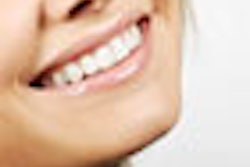
Teeth whitening is one of the most popular cosmetic procedures in dentistry today. But a new study has found that although it has a positive impact on patients' quality of life -- for instance they smile more without embarrassment -- it also has downsides, such as difficulty in brushing teeth and pain resulting from treatment (Journal of Dentistry, December 4, 2013).
Bleaching has become a popular procedure in dental offices, but the potential impact of the bleaching treatment on oral health-related quality of life is not well-addressed. This study fills that gap in knowledge, said study author Sônia Saeger Meireles, DDS, from the department of operative dentistry at the Federal University of Paraíba in Brazil, in an interview with DrBicuspid.com.
One study that assessed the sensitivity and responsiveness of an oral health-related quality of life measure to tooth whitening found that the greatest sensitivity and responsiveness were in relation to functional limitations (J Dent, September 2005, Vol. 33:8, pp. 697-702). Another study evaluated a sample of older adults. The authors reported that vital tooth whitening does not improve overall oral health-related quality of life in older adults (Journal of Dental Hygiene, Summer 2012, Vol. 86:3, pp. 239-247).
The current research is an independent study that was part of a long-term double-blind controlled randomized clinical trial by Dr. Meireles and colleagues that evaluated the whitening effect of 10% and 16% carbamide peroxide.
"We could measure oral health-related quality of life before and after bleaching treatment, so it was possible to determine the impact that the treatment produced in the individuals enrolled in the trial," Dr. Meireles said.
She added that since the most commonly reported side effects of tooth bleaching are tooth sensitivity and gingival irritation, they supposed that these effects could have a negative impact on quality of life. Likewise, since at-home bleaching gel produces a significant whitening effect, this benefit could have a positive effect.
For the study, 183 subjects volunteered to participate, and 92 of them met the researchers' inclusion criteria, which included having a mean shade of C1 or darker for the six maxillary anterior teeth. Approximately 50% of the study participants were between the ages of 18 to 20, while the rest were 21 to 30 years old.
Before a dental examination, each volunteer filled out a medical history form, and a complete dental prophylaxis was done to remove extrinsic stains. After the initial exam, the researchers noted the baseline tooth shade using a Vita shade guide and a digital spectrophotometer.
The study subjects were then randomly divided into two groups of 46. One group bleached with 10% carbamide peroxide, and the other used 16% carbamide peroxide. They both used whitening agents in a tray for two hours once a day for three weeks and bleached both arches simultaneously. They were given toothbrushes and dentifrices without whitening agents to standardize their oral hygiene regimen and were instructed to record tooth sensitivity on a daily basis for three weeks.
The participants completed the oral impact on daily performance questionnaire at the start of treatment and one week after the completion of treatment. The questionnaire asked the study participants about problems related to their oral health that caused difficulties with eating and enjoying food, speaking and pronouncing clearly, cleaning their teeth, sleeping and relaxing, smiling, laughing, and showing their teeth without embarrassment, maintaining their emotional state without becoming upset, carrying out their major work or social role, and/or enjoying contact with other people.
Since the authors found no difference between the two groups with regard to tooth color, whitening effect, or tooth sensitivity during or after treatment, they did not consider them separately when compiling the results.
The proportion of participants who reported difficulty with oral hygiene increased from 9.8% at baseline to 22.8% at the end of the study. On the other hand, the proportion that reported problems with smiling decreased from 9.8% to 3.3%.
In relation to negative symptoms, a higher number of participants reported pain after treatment than at baseline. However, the researchers also found a statistically significant decrease in individuals reporting being unhappy with their appearance.
More than 40% of the participants reported some sensitivity after three weeks of bleaching application. However, more than 80% of the reported sensitivity in the two bleaching protocols was classified as mild, indicating the low level of side effects observed with this technique.
"Home bleaching has increased negative impacts like discomfort, pain, and difficulty in performing oral hygiene, but positive impacts also were observed, like lower number of individuals reporting problems to smile or being unsatisfied with their appearance," Dr. Meireles said.
"It was reported that the elderly noticed less impact regarding aesthetics and dental sensibility to hot, cold, and sweet," she noted. Older individuals are more resilient, being more used to their dental appearance than younger ones, she explained.
"Younger individuals are more concerned with their teeth alignment and their tooth color, and so they might favor the observation of a 'positive' impact of bleaching treatment," Dr. Meireles said.
The study findings showed that at-home bleaching with 10% or 16% carbamide peroxide could have both positive and negative impacts on oral health-related quality of life, supporting the notion that professionals should handle patients undergoing bleaching treatment with extra care to obtain the best improvement in aesthetics, she concluded.



















